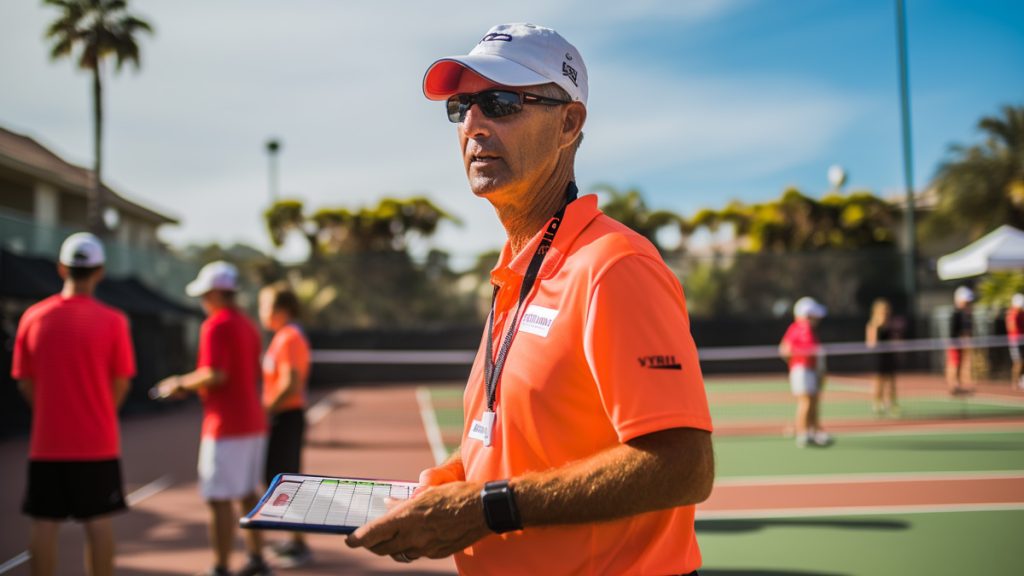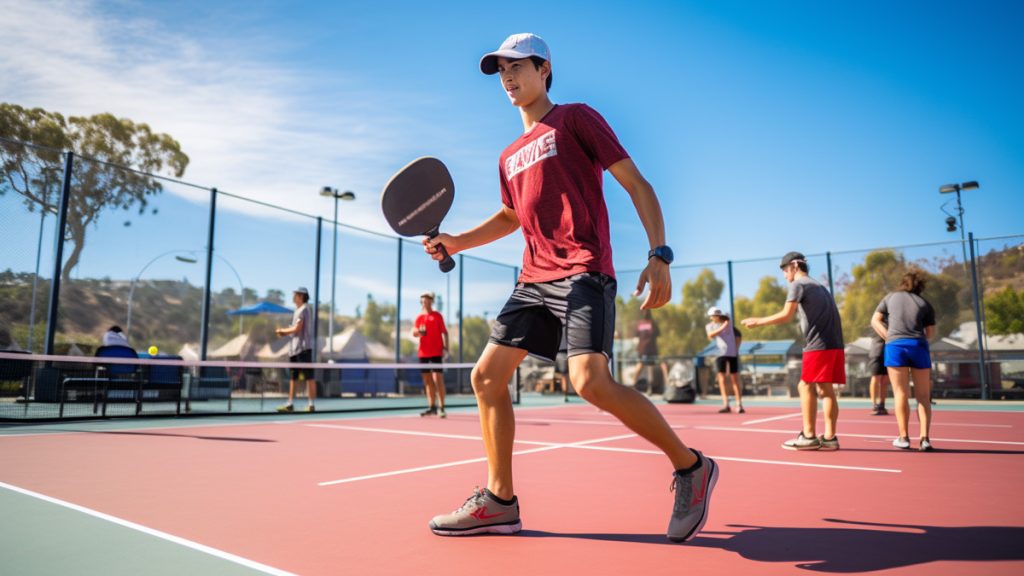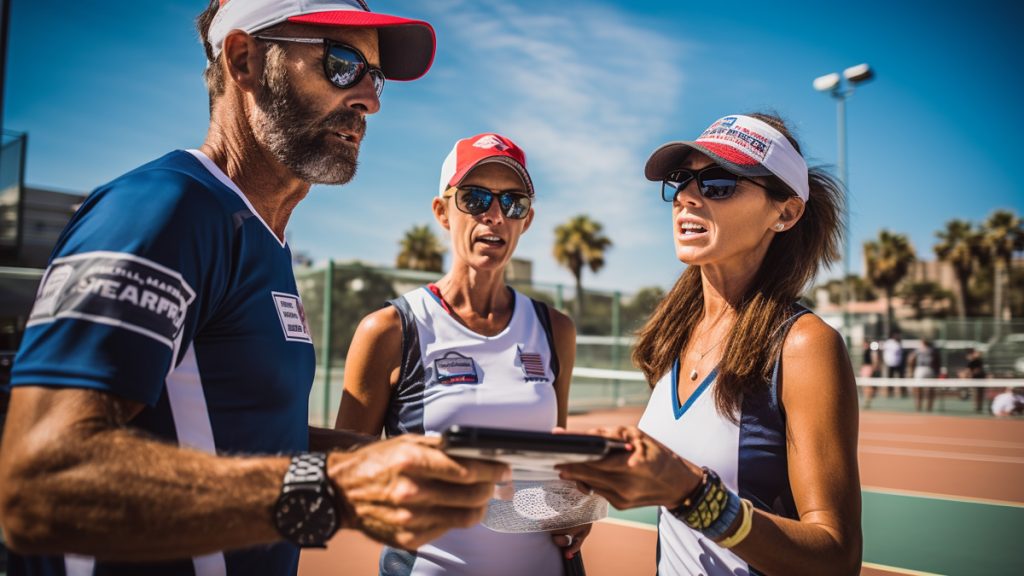Pickleball Rules Simplified: Play Like a Pro

If you want to play pickleball like a pro, you’ll need to learn a thing or two before you hop on the court. You can practice as many drills and tricks as you’d like, but your abilities mean nothing without confidence.
It’s important to start by getting acquainted with the rules, scoping websites like Pickleball Savant, which report on all things pickleball, including the latest high tech gear, game rules, stats on pros, and pretty much anything you can think of as it relates to what’s going on in the world of pickleball.
So let’s start there. How does one play pickleball, anyway?

Table of Contents
- How to Play Pickleball
- Pickleball Court Layout
- What You Need to Play Pickleball
- Scoring in Pickleball
- Single, Double, and First Serve
- What do the 3 Numbers in Pickleball Mean?
- What is the Golden Rule in Pickleball?
- What is the Two Bounce Rule in Pickleball
- How Do You Win in Pickleball?
- The USA Pickleball Rulebook
- Common Misinterpretations of the USA Pickleball Rules
How to Play Pickleball
Due to its immense popularity among young folks, pickleball might seem like a difficult entry point that requires athleticism and super strength, but that’s not necessarily true! For competitive leagues, sure, these must have skills, but for beginners, the rules are fairly easy to follow, and after some time and practice or a few pickleball lessons, it’s easy to get the hang of the basics of the sport. For starters, the goal is to rally back and forth, with the objective of winning points on your opponent.
So you may love the idea of pickleball, but do you actually play by the pickleball rules?
To start a game, decide who serves first. Rock paper scissors, pick a number between 1-100, whatever floats your boat that is fair and quick. The Player starting on the right hand side of the court will serve first, using an underhand serve or a drop serve and standing behind the baseline.
The serving rules include: serve must go to the other side of the court, serve must bounce, return must bounce, and from there you can hit a volley. All shots in the pickleball court or on the lines of the court are in, except that the serve must be in the service box beyond the kitchen line. If the serve hits the kitchen or the kitchen line, then it’s out. Each player gets the chance to serve, but note that you are only able to score if you’re the serving team.
If you happen to lose a rally as a serving team, serve moves to the next player. If the serve goes to the other side of the court, which is called a side out, then the person on the right hand side of the court will go first in doubles pickleball.
Once both sides have had a bounce, the rally will continue till someone makes a mistake. There are three main ways someone can make a fault: by hitting the ball out of bounds, by hitting the ball into the net, and by hitting a double bounce. That said, there are a few exceptions for a double bounce. Another mishit includes hitting a ball before it bounces while standing in the non-volley zone–also known as the kitchen. Keep reading on to learn more.
Pickleball can be played as a doubles or singles game. In singles pickleball, the server serves on the side of the court based on their score. In doubles, the first serving team only has one service term. To start a game, shout out loudly the score, which you will continue to do before every single serve. This helps keep all the players aligned on their teams score and their serving sides turns.
Anything considered “out” is only called out by the team on the same side where the pickleball bounces. If this is your team, call it loudly. Similarly, shout out scores loudly before every serve. To play well and strategically, you’ll want to assess, analyze, and develop a plan. Thinking on your toes is a must.

Pickleball Court Layout
The court layout is simple and is the same size as a doubles badminton court. It measures 44 feet long and 20 feet wide–including the lines of the court. Whether you are playing singles or doubles, the court remains the same. Despite the court size, you will need additional space around the court to allow players to move around to reach shots. If you are building a pickleball court for your country club or backyard, you’ll want at least 24 feet by 54 feet of space or even larger to ensure optimal playing area.
Within the pickleball court is a 7 foot area on either side of the net called the non-volley zone (NVZ) or the kitchen. This is the no-no zone where you are not allowed to hit a volley into the air.
What You Need to Play Pickleball
Now that we’ve addressed how to play pickleball and what the court looks like, it’s time to go over the gear and equipment. Aside from a court, in order to play pickleball you’ll first need a pickleball ball–typically a perforated plastic ball–and at least two paddles, a court to play on, and court shoes or tennis shoes. Proper shoes that will facilitate you in moving around at a quick pace and run from one side of the court to the other are what you’re looking for when you hit the shoe store.
Whether you are playing indoor or outdoor pickleball will also determine what type of pickleball you use, as outdoor pickleballs and indoor pickleballs differ slightly in composition, durability, and the number of holes on the ball. Indoor pickleballs have a softer plastic composition, designed for controlled environments–i.e for indoors. Outdoor pickleballs tend to be more durable, with around 40 smaller holes, and indoor pickleball balls will have fewer, larger holes–around 26 holes.
Outdoor balls tend to be heavier than indoor pickle balls, with harder plastic due to the nature of the environment they are played in, Because the plastic is harder, this can cause outdoor pickleballs to crack easier than indoor. Believe it or not, the size, durability, and number holes on the ball does indeed affect game play, so keep that in mind.
You’ll want to invest in a decent paddle, though it is recommended to steer clear of wooden paddles as they are heavy and can cause fatigue. You’ll likely also outgrow them rather fast. With that in mind, opt for a composite paddle that is light to medium weight to start. You can always work your way up to a more high-tech, heavier paddle. When choosing a paddle–don’t be afraid to ask questions to a gear shop pro! That’s what they are there for, and they can truly tailor your experience by finding you the perfect pickleball paddle to meet your specific needs.
Other things you’ll need to bring with you to pickleball are a positive attitude and good team spirit. Agility, strength, and flexibility are all bonuses, and will come with time if you stretch properly before and after games, practice technique and skills using drills and repetition, do supplemental strength training, and stay committed to the craft.
Scoring in Pickleball
You call the score in a specific order, always each time before hitting servers score – receivers score – server number.
To paint a better picture, if the serving team’s score is 7 and the receiving team’s score is 4, and the first server on the serving side is up to serve, the score is 7-4-1. If the former two are true and instead of the first server on the serving side serving, it is the second server, the score would be 7-4-2. It doesn’t get easier than that!
Pickleball rules and scoring requires the server to speak aloud the score before each turn to keep everybody in check, and the winner must win by a 2 point lead, will 11 points typically ending the game. If one side has 10 points and the other has 11, the game continues until one side is in the lead by 2 points.

Single, Double, and First Serve
Pickleball serving rules are fairly straight forward. During the first serve, the game commences and only one player serves, The server shouts aloud “zero-zero-start.” Note that the server must serve underhand, from behind the baseline, and the serve must go cross court diagonally, out of the non-volley zone. On a serve, a ball that makes contact with any line–with the exception of the NVZ line–is counted as “in.” If the serve hits the NVZ, it is considered short and deemed a fault. There are no volleys allowed in the kitchen! If you see a volley in the kitchen, call the kitchen or out if it is received on your side.
Both players on each team can serve before the ball is given to the opponent. If the serving team wins a rally, they get a point and switch sides. If, on the other hand, the serving team loses, everyone stays put–no switching sides. No points are awarded, and the serve goes to the next person,
Singles is less popular than doubles, namely because it is less of a team sport. Some people prefer playing on their own against one other player, though generally people like the collaborative, community-based aspect of pickleball that is reinforced during doubles games. Playing singles also means more groundwork to cover, as doubles require less court space for players to move around. Those who are not looking for intense cardio but still good exercise tend to prefer doubles.
What do the 3 Numbers in Pickleball Mean?
Covering the basic pickleball rules for beginners, we’ve discussed how scoring works, though it is important to note that the 3 numbers only applies to doubles games. In doubles–first number is the serving team’s score, middle number is the receiving team’s score–and the last number is the server number. This number is never higher than 2, because there are only two players on a serving team in doubles–or either team–in doubles games. For example, someone can’t shout out 9-3-3 because the last number can never be higher than 2.
Conversely, in singles the score will only consist of two numbers. This is because each side will only have one service turn (for example 0 -2). In other words, The first two digits operate the same as singles pickleball and can go up to 11 points, or even higher if there isn’t a 2 point lead. Some games such as tournaments call end points on 15 or 21.
What is the Golden Rule in Pickleball?
Of all the Pickleball Rules, the #1 rule to remember–also known as the Golden Rule–is that you should always fully engage your body. Be proactive, not reactive. You are using the full force of your body, and hand-eye coordination and fancy footwork is key. Often you will simultaneously have to move around the court, sometimes back pedaling or split stepping, while swinging at the ball. Engaging your body and practicing observing while taking action is a must.
Other important things to be aware of include recovering in between shots and having eyes on the ball as much as you can.You might hit an amazing shot, but if you don’t move your body or adjust your position accordingly after your shot, you could lose a point for your team or make an error that could be prevented. Rule of thumb–stand behind the baseline, as it is easier to track the ball with your eyes from behind this line.
When you release a shot, exhale. When you are getting ready to prepare, inhale, The rhythm is simple–inhale to prepare, exhale to strike. This will aid in syncing you up with your breath to movement flow. It also can be useful to explore other activities to get a clear head. Check out some must do’s in San Diego that are an exciting way to explore the city and rejuvenate the mind before a big game–or as a reward after crushing a game!
Just remember, consistency is key, and the more accurate you are, the less buffer you will need before a shot. The more you focus on control, power, spin, and precision, the more confident you will be and the more you have on your opponent,

What is the Two Bounce Rule in Pickleball
The “two bounce rule” in pickleball simply states that you must bounce the pickleball on either side of the court–so each team’s side–before a score can be made. Only after the ball bounces on either side can you rally or seek out more challenging shots to trick your opponent. You also are not allowed to intentionally double bounce the ball.
How Do You Win in Pickleball?
Winning pickleball requires skill and dexterity, and–for those playing on teams–collaboration. But that’s not all–you must practice the art of staying positive and remaining confident, even if your opponent is in the lead. Be your own cheerleader! Pat yourself on the back when you hit a nice shot or win a point! Positive reinforcements are everything.
Of equal importance, congratulate your teammate when they manage to return a difficult shot, and give them words of encouragement even when they miss a shot. Let your partner know they’re doing well–it really helps with keeping your head in the game. “great play” or “nice shot!” are wonderful ways to offer up recognition to your pickleball partner. Paddle tapping is another way to express “go team go” without words.
In order to win in pickleball, you must also learn to impose yourself and your partners strengths onto your opponents weaknesses. Notice where the people you are competing against have shortcomings, and use that to your advantage.
Eager to play other racket sports in San Diego? You’re in luck, because there are tons of local tennis clubs with potential for pickleball, so you can bring a racket, tennis ball, and your pickleball paddle and pickleball with you in case you want to swap between the two.
The USA Pickleball Rulebook
There are, of course, other rules and regulations as well as rare occurrences that are outlined in detail in the official USA pickleball rulebook. This is a great book to reference if you want to play properly and plan to rise up to tournaments and competitive matches. This book also includes definitions, scoring rules, the service sequence, dead ball rules, time-out rules, NVZ rules, sanctioned tournament policies, and beyond.There are even tournament management guidelines in there for those planning to host tournaments.
The 2024 edition is 88 pages and encompasses significant real changes for the new year moving forward. They are constantly updating to ensure that the latest edition is available to everyone. Some newer rules in the book include catching or carrying the ball on the paddle as a fault without having to determine whether it was deliberately done. There is also a mini singles, newly approved format with specific rules that govern said game addressed in the rulebook.

Common Misinterpretations of the USA Pickleball Rules
Did you know that nearly 3/4ths of all rallies losses are due to unforced errors. This statistic alone should make wanting to learn the rules of pickleball all the more of a priority for those who actually care about winning the game. Common misinterpretations of the rules include double hits being permissible, but not during the right place and time. Double hits must be unintentional, continuous, and single-direction strokes. If you intentionally try to hit a double hit, that is considered a fault.
If you’re confused on any rules, always refer to the USA Pickleball Rulebook for guidance and clarification.
In summary…
- You must serve underhand with the paddle below your wrist, and the point of contact with the ball must be made below your waist
- A point is scored only with the serving team
- You must announce the score every play, starting with the serving side’s score – the opponents score – and the server’s number.
- You cannot hit the ball out of the air in the non-volley zone (aka kitchen).
- Faults or mishits include the ball going out of bounds, into net, or hitting ball before it bounces while standing in the NVZ
- The first team to get to 11 points–with a 2 point lead–wins the game
- Indoor pickleball holes have a wider diameter than outdoor balls, and they vary in durability, number of holes, and composition
- Back pedal while keeping your eye on the ball to ensure safe recovery after a hit
When you’re out there, have a plan! Don’t underestimate the power of strategy. Pre-game rituals can also really help to get your head in the game. Now that you know all about pickleball rules, get ready for action and prime yourself by exploring some other outdoor activities in San Diego.
Media credits: Unless otherwise noted, the conceptual images of pickleball rules in this article are copyright of LaJolla.com.





